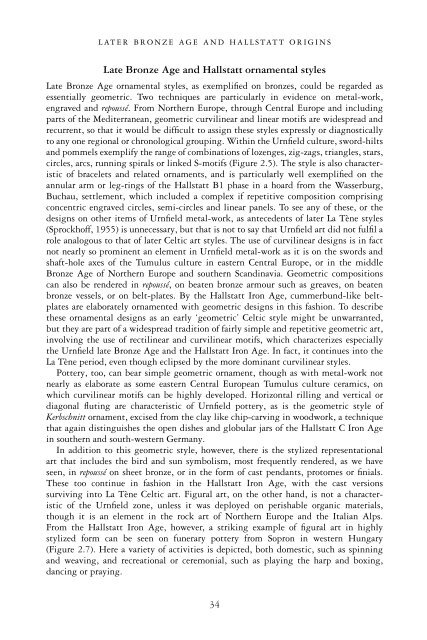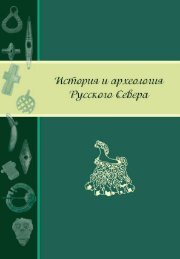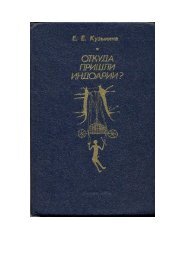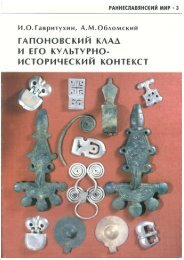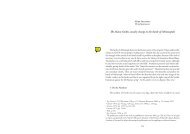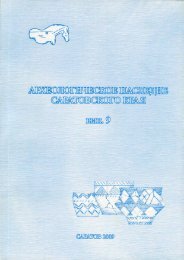The Archaeology of Celtic Art
The Archaeology of Celtic Art
The Archaeology of Celtic Art
- No tags were found...
Create successful ePaper yourself
Turn your PDF publications into a flip-book with our unique Google optimized e-Paper software.
LATER BRONZE AGE AND HALLSTATT ORIGINSLate Bronze Age and Hallstatt ornamental stylesLate Bronze Age ornamental styles, as exemplified on bronzes, could be regarded asessentially geometric. Two techniques are particularly in evidence on metal-work,engraved and repoussé. From Northern Europe, through Central Europe and includingparts <strong>of</strong> the Mediterranean, geometric curvilinear and linear motifs are widespread andrecurrent, so that it would be difficult to assign these styles expressly or diagnosticallyto any one regional or chronological grouping. Within the Urnfield culture, sword-hiltsand pommels exemplify the range <strong>of</strong> combinations <strong>of</strong> lozenges, zig-zags, triangles, stars,circles, arcs, running spirals or linked S-motifs (Figure 2.5). <strong>The</strong> style is also characteristic<strong>of</strong> bracelets and related ornaments, and is particularly well exemplified on theannular arm or leg-rings <strong>of</strong> the Hallstatt B1 phase in a hoard from the Wasserburg,Buchau, settlement, which included a complex if repetitive composition comprisingconcentric engraved circles, semi-circles and linear panels. To see any <strong>of</strong> these, or thedesigns on other items <strong>of</strong> Urnfield metal-work, as antecedents <strong>of</strong> later La Tène styles(Sprockh<strong>of</strong>f, 1955) is unnecessary, but that is not to say that Urnfield art did not fulfil arole analogous to that <strong>of</strong> later <strong>Celtic</strong> art styles. <strong>The</strong> use <strong>of</strong> curvilinear designs is in factnot nearly so prominent an element in Urnfield metal-work as it is on the swords andshaft-hole axes <strong>of</strong> the Tumulus culture in eastern Central Europe, or in the middleBronze Age <strong>of</strong> Northern Europe and southern Scandinavia. Geometric compositionscan also be rendered in repoussé, on beaten bronze armour such as greaves, on beatenbronze vessels, or on belt-plates. By the Hallstatt Iron Age, cummerbund-like beltplatesare elaborately ornamented with geometric designs in this fashion. To describethese ornamental designs as an early ‘geometric’ <strong>Celtic</strong> style might be unwarranted,but they are part <strong>of</strong> a widespread tradition <strong>of</strong> fairly simple and repetitive geometric art,involving the use <strong>of</strong> rectilinear and curvilinear motifs, which characterizes especiallythe Urnfield late Bronze Age and the Hallstatt Iron Age. In fact, it continues into theLa Tène period, even though eclipsed by the more dominant curvilinear styles.Pottery, too, can bear simple geometric ornament, though as with metal-work notnearly as elaborate as some eastern Central European Tumulus culture ceramics, onwhich curvilinear motifs can be highly developed. Horizontal rilling and vertical ordiagonal fluting are characteristic <strong>of</strong> Urnfield pottery, as is the geometric style <strong>of</strong>Kerbschnitt ornament, excised from the clay like chip-carving in woodwork, a techniquethat again distinguishes the open dishes and globular jars <strong>of</strong> the Hallstatt C Iron Agein southern and south-western Germany.In addition to this geometric style, however, there is the stylized representationalart that includes the bird and sun symbolism, most frequently rendered, as we haveseen, in repoussé on sheet bronze, or in the form <strong>of</strong> cast pendants, protomes or finials.<strong>The</strong>se too continue in fashion in the Hallstatt Iron Age, with the cast versionssurviving into La Tène <strong>Celtic</strong> art. Figural art, on the other hand, is not a characteristic<strong>of</strong> the Urnfield zone, unless it was deployed on perishable organic materials,though it is an element in the rock art <strong>of</strong> Northern Europe and the Italian Alps.From the Hallstatt Iron Age, however, a striking example <strong>of</strong> figural art in highlystylized form can be seen on funerary pottery from Sopron in western Hungary(Figure 2.7). Here a variety <strong>of</strong> activities is depicted, both domestic, such as spinningand weaving, and recreational or ceremonial, such as playing the harp and boxing,dancing or praying.34


